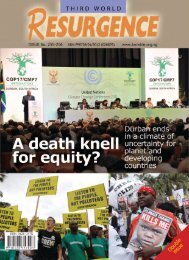Plantations, poverty and power - Critical Information Collective
Plantations, poverty and power - Critical Information Collective
Plantations, poverty and power - Critical Information Collective
Create successful ePaper yourself
Turn your PDF publications into a flip-book with our unique Google optimized e-Paper software.
37<br />
Sappi, Swazil<strong>and</strong>: 50 years of industrial forestry fails to bring benefits for local people<br />
Sappi, a South African pulp <strong>and</strong> paper company, rents almost 70,000 hectares of l<strong>and</strong> from the Swazil<strong>and</strong><br />
state, of which 54,212 hectares are planted with exotic pine trees. Sappi’s plantations in Swazil<strong>and</strong> are the<br />
epitome of what is wrong with industrial tree plantations. Species-rich grassl<strong>and</strong>s were destroyed <strong>and</strong><br />
people moved to make way for the plantations.<br />
Every year, Sappi clearcuts a total area of 3,000 hectares of plantations, leaving vast scars on the<br />
l<strong>and</strong>scape. When the clearcuts are replanted, the trees suck up water, drying up streams <strong>and</strong> reducing flow<br />
in rivers. Sappi’s plantations <strong>and</strong> nurseries can only be managed through the use of chemical pesticides.<br />
What are today Sappi’s industrial tree plantations arrived in Swazil<strong>and</strong> as the result of an “aid” project<br />
funded by the UK’s Colonial Development Corporation. In 1948, Sir Evelyn Baring, then-High<br />
Commissioner for Swazil<strong>and</strong>, commissioned Dr Ian J. Craib to produce a study to look at the possibility<br />
of converting 55,000 hectares of grassl<strong>and</strong> in the Great Usutu valley to tree plantations. Craib was a<br />
forester <strong>and</strong> managing director of Peak Timbers, another plantations operation in Swazil<strong>and</strong>. 156 Not<br />
surprisingly, given his background, Craib favoured exp<strong>and</strong>ing the area of industrial tree plantations.<br />
CDC funded the l<strong>and</strong> purchase <strong>and</strong> planting started in 1950. By 1958, Swazil<strong>and</strong> had the largest<br />
continuous area of plantations in Africa. In 1959, Courtaulds, a UK company, formed a joint venture with<br />
CDC to build a pulp mill. The mill opened in 1962, with a capacity of 90,000 tons a year. 157 The mill now<br />
produces about 200,000 tonnes of unbleached kraft pulp a year.<br />
Set up as the Colonial Development Corporation in 1948, CDC’s initial brief was “to develop resources<br />
of Britain’s colonies”. In 1963, it changed its name to the Commonwealth Development Corporation.<br />
Now called the CDC Group, it invests UK tax-payers’ money in the Global South through a series of<br />
finance houses. 158 A bizarre privatisation process allowed the directors of CDC to earn huge amounts of<br />
money, by selling CDC’s fund management arm to themselves for a pittance, renaming it Actis <strong>and</strong><br />
running it as a private equity company. 159 CDC’s only shareholder is the Department for International<br />
Development, the UK’s bilateral aid agency. 160<br />
In the late 1980s, despite having been involved in a series of disastrous aid projects, Peter Eccles, CDC’s<br />
general manager, described CDC as the “jewel in the British aid crown”. CDC held up its involvement in<br />
Swazil<strong>and</strong> as a success story. In Swazil<strong>and</strong>, as well as the Usutu pulp mill <strong>and</strong> its associated pine<br />
plantations, CDC has supported sugar plantations.<br />
156 Julian Evans (1988) “The Usutu forest: Twenty years later”, Unasylva, Vol. 40, No. 159, Food <strong>and</strong> Agriculture<br />
Organization of the United Nations.<br />
http://www.fao.org/docrep/s5780e/s5780e04.htm#the%20usutu%20forest:%20twenty%20years%20later<br />
157 Julian Evans (1988) “The Usutu forest: Twenty years later”, Unasylva, Vol. 40, No. 159, Food <strong>and</strong> Agriculture<br />
Organization of the United Nations.<br />
http://www.fao.org/docrep/s5780e/s5780e04.htm#the%20usutu%20forest:%20twenty%20years%20later<br />
158 “Who we are: History”, CDC Group website: http://www.cdcgroup.com/history.asp<br />
159 “Actis & the consultants: The big buy-out sell-out”, Private Eye, No. 1206, 21 March - 3 April 2008, page 29.<br />
“The Actis sc<strong>and</strong>al: The price is frightful”, Private Eye, No. 1210, 16-29 May 2008, page 29.<br />
“Actis: False Profits”, Private Eye, No. 1212, 13-26 June 2008, page 27.<br />
160 “Who we are: Corporate Structure”, CDC Group website:<br />
http://www.cdcgroup.com/~archive/corporate_structure.asp















